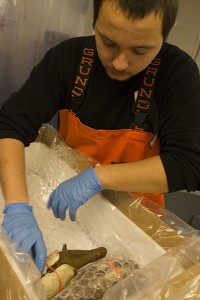By Rob Ollikainen , Peninsula Daily News
PORT TOWNSEND — Lethal levels of marine biotoxins that cause paralytic shellfish poisoning have been detected in shellfish taken from Quilcene Bay, Jefferson County health officials warned Monday.
Quilcene and Dabob bays have been closed to the recreational harvest of molluscan shellfish — clams, oysters, mussels and scallops — since Sept. 8.
Paralytic shellfish poisoning, or PSP, concentrations have risen to more than 6,000 micrograms per 100 grams of shellfish.
That’s 75 times the 80-microgram closure level, and twice the levels detected last week.
“It keeps climbing,” said Michael Dawson, water quality lead for Jefferson County Environmental Health.
A combination of warm weather and calm water may be contributing to the elevated levels of PSP, Dawson said
Additional samples from Quilcene Bay and surrounding areas were collected Monday.
“Right now, we’re mostly wanting to check and see if it might be spreading,” Dawson said.
“So we’ve been checking down the Hood Canal.”
The state Department of Health is warning the public that eating shellfish with such high amounts of toxin is potentially deadly.
Symptoms of PSP can appear within minutes and usually begins with tingling lips and tongue moving to the hands and feet, followed by difficulty breathing and potentially death.
Danger signs have been posted at public beaches warning the public not to eat the shellfish, Dawson said.
Marine biotoxins are not destroyed by cooking or freezing.
The closure does not apply to shrimp.
Crabmeat is not known to contain the biotoxin, but the guts can contain unsafe levels.
To be safe, clean crab thoroughly and discard the guts, health officials say.
Commercially-harvested shellfish are tested for toxins prior to distribution and should be safe to eat.
Areas closed to the recreational harvest of all species of shellfish in Jefferson County are Quilcene Bay, Dabob Bay and Discovery Bay.
Kilisut Harbor, including Mystery Bay, and the Port Ludlow area are closed to the recreational harvest of butter and varnish clams only.
Jefferson County Public Health will continue to test affected beaches and will notify the public when shellfish are safe to harvest, officials said.
In Clallam County, the recreational harvest of butter clams is closed from Cape Flattery to Dungeness Spit.
Varnish clams are closed along the entire North Olympic Peninsula.
Sequim Bay is closed to all species of shellfish.
Seasonal closures are in effect for the Pacific Ocean beaches.
Recreational shellfish harvesters can get the latest information about the safety of shellfish on the state website at www.doh.wa.gov or by phoning 800-562-5632 before harvesting shellfish anywhere in the state.
Recreational shellfishers also should consult state Fish and Wildlife at www.wdfw.wa.gov.


